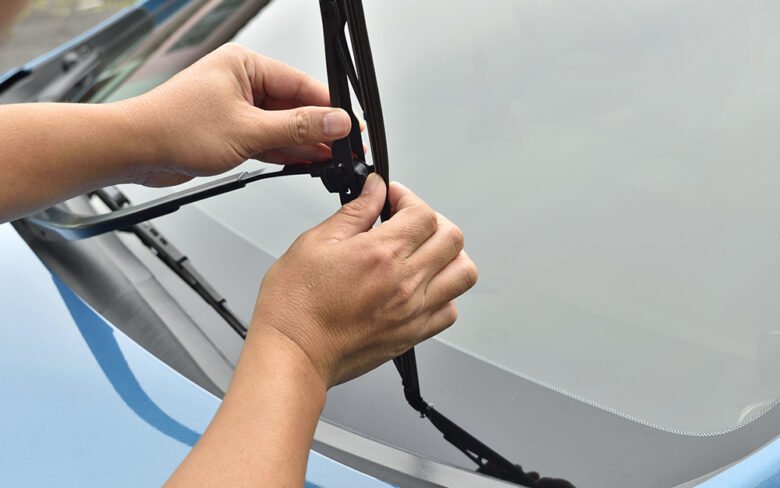Windshield wipers are an often-overlooked yet vital part of your vehicle’s safety system. They ensure clear visibility in adverse weather conditions such as rain, snow, sleet, and even dusty environments. However, like any other component exposed to the elements, wiper blades degrade over time. Worn-out wipers can leave you struggling to see the road ahead, increasing the risk of accidents. Understanding when your windshield wipers need replacement and how to perform this straightforward task can save you time, money, and potentially your life. This detailed guide will walk you through the signs of wear, the selection process, step-by-step replacement instructions, maintenance tips, and common pitfalls to avoid.
1. Signs That Your Windshield Wipers Need Replacement
Windshield wipers don’t last forever. On average, they perform well for 6 to 12 months, though their lifespan varies based on factors like frequency of use, weather conditions, and exposure to sunlight or freezing temperatures. Recognizing the warning signs of deteriorating wiper blades is key to maintaining your safety on the road. Below are the most common indicators that it’s time to replace your wipers, explained in detail.
1.1 Streaking or Smearing
When your wipers leave streaks or smears across the windshield instead of wiping it clean, it’s a clear sign that the rubber blades have worn out or become compromised. Streaking occurs when the rubber edge, which makes direct contact with the glass, hardens, cracks, or collects debris like dirt, dust, or road grime. Over time, this buildup reduces the blade’s ability to conform to the windshield’s curvature, leaving behind streaks that obscure your view. If cleaning the blades and windshield with a damp cloth and mild soap doesn’t resolve the issue, replacement is the next step. Persistent streaking not only hampers visibility but can also strain your eyes, especially during long drives in poor weather.
1.2 Squeaking or Chattering Sounds
A properly functioning wiper glides silently across the windshield. If you hear squeaking, chattering, or scraping noises, the rubber has likely hardened or cracked, preventing smooth movement. This problem often stems from prolonged exposure to ultraviolet (UV) rays from the sun, which degrade the rubber over time, or extreme cold, which makes it brittle. Dirt or debris trapped between the blade and glass can also cause these noises. While a quick cleaning might temporarily quiet the wipers, persistent sounds indicate that the rubber has lost its elasticity and needs replacing. Ignoring this issue can lead to uneven wiping and further windshield wear.
1.3 Skipping or Inconsistent Contact
If your wiper blades skip across the windshield or fail to clean certain areas, they may no longer maintain consistent contact with the glass. This “skipping” happens when the blades lose flexibility or when the wiper arm’s pressure distribution becomes uneven. Over time, the rubber can warp or the metal frame can bend, causing gaps where water and debris remain. These missed spots can significantly impair visibility, particularly in heavy rain or snow. If adjusting the arm tension doesn’t fix the problem, new blades are necessary to restore full coverage.
1.4 Visible Wear and Tear
A physical inspection of your wiper blades can reveal obvious signs of damage. Look for cracks, splits, or tears in the rubber, which indicate that the blade can no longer seal against the windshield effectively. Warping—where the rubber bends or curls unnaturally—is another red flag. Additionally, check the wiper frame or attachment points for rust, bending, or corrosion. A damaged frame can misalign the blade, reducing its wiping efficiency and potentially scratching the glass. Any of these visible issues warrants immediate replacement to avoid compromising your safety.
1.5 Reduced Effectiveness in Rain
The ultimate test of wiper performance comes during rainfall. If your wipers struggle to clear water, leaving droplets or a hazy film on the windshield, they’ve lost their effectiveness. This issue is especially dangerous in heavy downpours, where poor visibility can make driving treacherous. Aging rubber loses its ability to repel water efficiently, and worn blades may smear rather than wipe. If you notice this problem, don’t delay—replace the wipers promptly to ensure a clear line of sight in all conditions.
2. Choosing the Right Windshield Wipers
Not all wiper blades are created equal, and selecting the right ones for your vehicle is critical for optimal performance. A poor choice can lead to inadequate wiping, excessive noise, or even damage to your wiper system. Here’s a detailed breakdown of what to consider when shopping for replacements.
2.1 Find the Right Size
Wiper blades are not one-size-fits-all. Each vehicle requires specific blade lengths to ensure full windshield coverage without overlap or gaps. Using blades that are too short leaves unwiped areas, while overly long blades may collide with each other or the windshield frame, causing noise or damage. To determine the correct size, consult your car’s owner’s manual, which lists the manufacturer’s recommendations. Alternatively, many auto parts stores and online retailers offer compatibility tools—just enter your vehicle’s make, model, and year. Measuring your existing blades with a tape measure is another option, though it’s wise to double-check against official specifications.
2.2 Choose Between Different Types of Wiper Blades
Wiper blades come in several designs, each with unique advantages suited to different driving conditions and budgets. Here’s a closer look at the main types:
-
- Conventional Blades: These traditional blades feature a metal frame with a rubber wiping edge. They’re affordable and widely available, making them a popular choice for older vehicles or mild climates. However, their multi-piece design can collect ice and debris, reducing performance in harsh weather.
-
- Beam Blades: Constructed from a single, flexible piece of rubber, beam blades lack a metal frame. This design allows them to hug the windshield’s curve more effectively, providing even pressure and superior wiping in rain, snow, and wind. They’re more durable and aerodynamic, making them ideal for modern vehicles and severe weather conditions.
-
- Hybrid Blades: Combining the best of both worlds, hybrid blades feature a rubber edge supported by a lightweight frame. They offer the durability and flexibility of beam blades with the structural stability of conventional blades. Their sleek design also improves performance at high speeds, making them a premium option for all-around use.
2.3 Consider Additional Features
Beyond basic design, some wiper blades come with specialized features tailored to specific needs:
-
- All-Season Blades: Engineered to withstand extreme heat and cold, these blades are perfect for regions with unpredictable weather. Their robust rubber resists cracking in summer sun and freezing in winter frost.
-
- Silicone Blades: Unlike standard rubber, silicone blades are more durable and naturally repel water, causing rain to bead and slide off the windshield. This enhances visibility and reduces the workload on your wipers, extending their lifespan.
-
- Heated Wipers: Designed for cold climates, heated wiper blades use built-in elements to prevent ice buildup. They’re a game-changer in snowy conditions, ensuring consistent performance when traditional blades might freeze solid.
3. How to Replace Your Windshield Wipers
Replacing windshield wipers is a quick, tool-free task that anyone can do with a little care. Follow these detailed steps to swap out your old blades for new ones.
3.1 Prepare for Replacement
-
- Turn Off the Engine: Park your vehicle on a level surface and ensure the ignition is off to prevent the wipers from moving unexpectedly.
-
- Lift the Wiper Arms: Carefully lift each wiper arm away from the windshield until it locks into an upright position. Handle the arms gently—releasing them too quickly can cause them to snap back and crack the glass.
3.2 Remove the Old Wiper Blades
-
- Locate the attachment point where the blade connects to the arm. Most designs feature a small tab, latch, or button.
-
- Press or release the tab while sliding the blade downward off the arm’s hook or pin. Some models may require a slight twist or wiggle to detach.
-
- Lower the arm slowly back to the windshield to avoid sudden impacts. Repeat for the second wiper.
3.3 Install the New Wiper Blades
-
- Unpack your new blades and align the attachment mechanism with the wiper arm’s hook or connector.
-
- Slide the blade upward or snap it into place until you hear a click, indicating a secure fit. Tug gently to confirm it’s locked in.
-
- Carefully lower the arm back onto the windshield. Repeat the process for the other side.
3.4 Test the New Wipers
-
- Start the engine and activate the wipers using the control stalk.
-
- Spray windshield washer fluid to lubricate the blades and observe their performance. Check for smooth, streak-free wiping across the entire windshield.
-
- Listen for unusual noises and ensure there are no gaps or skipped areas. If something seems off, lift the arm again to reposition the blade or verify the attachment.
4. Tips for Maintaining Your Windshield Wipers
Proper care can extend the life of your wiper blades and keep them performing at their best. Incorporate these habits into your routine:
4.1 Clean the Blades Regularly
Wipe the rubber edges with a damp cloth every few weeks to remove dirt, bugs, and grime. For stubborn buildup, use a mild soap solution or rubbing alcohol, then rinse thoroughly. This prevents abrasive particles from wearing down the rubber prematurely.
4.2 Keep Your Windshield Clean
A dirty windshield accelerates blade wear by forcing the wipers to work harder. Wash the glass regularly with an automotive glass cleaner to remove grit and maintain clarity. A clean surface also reduces friction, preserving the rubber’s flexibility.
4.3 Avoid Using Wipers on a Dry Windshield
Running wipers without moisture creates unnecessary friction, tearing the rubber and shortening its life. Always use windshield washer fluid or wait for rain before engaging the wipers. If fluid is low, refill it with a high-quality solution to avoid freezing or residue.
4.4 Lift Wipers in Freezing Conditions
In winter, lift the wiper arms off the windshield when parking overnight to prevent them from freezing to the glass. This simple step avoids tearing the rubber or straining the wiper motor when you start the car.
4.5 Replace Wipers Annually
Even if your blades look fine, replace them yearly as a preventive measure. Rubber naturally degrades over time, and fresh blades ensure peak performance when you need it most—especially during sudden storms.
5. Common Mistakes to Avoid
Steer clear of these frequent errors to get the most out of your wiper replacement:
-
- Using the Wrong Size Blades: Incorrect lengths compromise wiping efficiency and can damage the wiper arms or windshield.
-
- Neglecting to Change Both Blades: Wipers wear out at similar rates, so replace them as a pair to maintain balanced performance.
-
- Forgetting to Check the Rear Wiper: If your vehicle has a rear wiper, inspect and replace it as needed—visibility out the back is just as important.
-
- Not Using Quality Wiper Fluid: Cheap fluids or plain water can leave residue or freeze in cold weather, reducing blade life and visibility.
Final Thoughts
Windshield wipers are a small but indispensable part of your vehicle’s safety toolkit. By regularly checking for signs of wear, choosing the right replacement blades, and following proper installation and maintenance practices, you can ensure clear visibility in any weather. This DIY task requires minimal effort but delivers maximum peace of mind, keeping you safe and comfortable on the road year-round. Don’t wait for a downpour to reveal failing wipers—stay proactive and drive with confidence.




